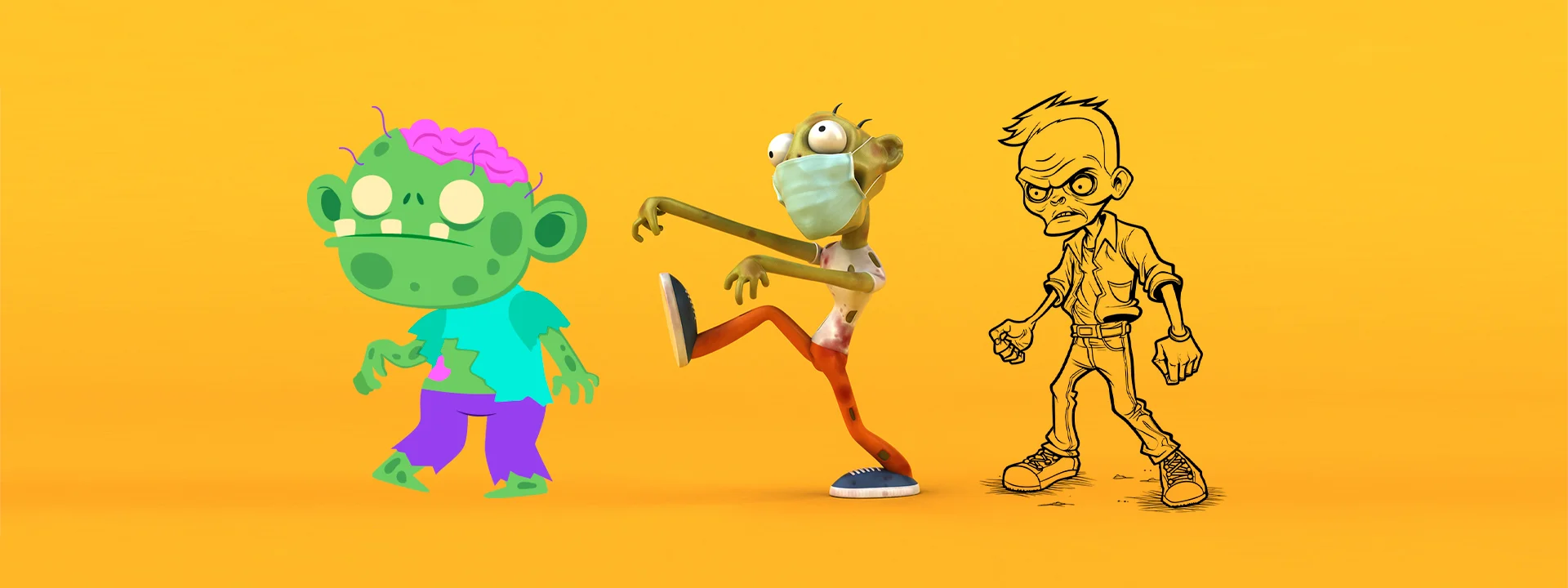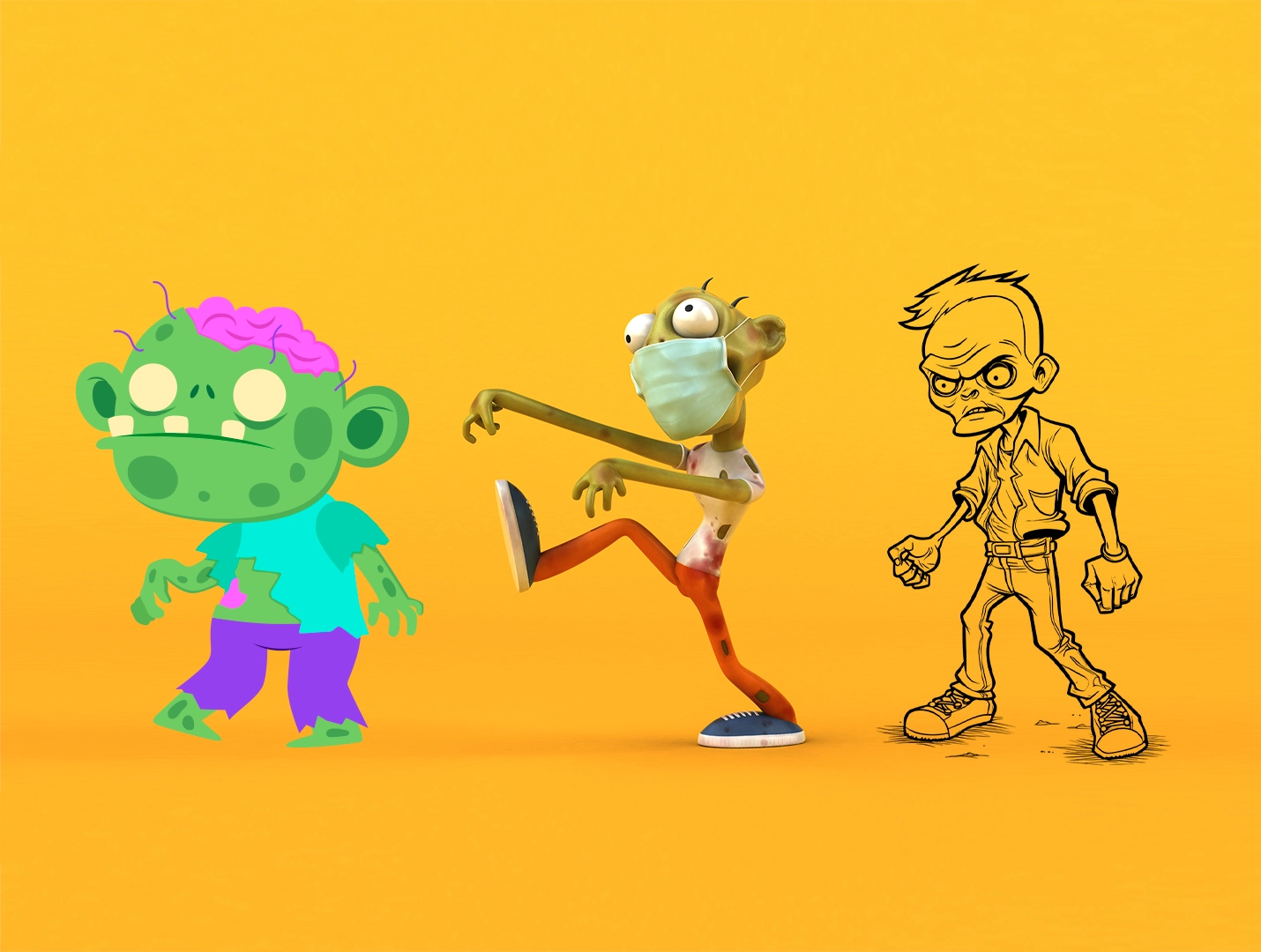

DIFFERENT TYPES OF ANIMATION AND WHAT THEY ARE USED FOR
There’s a lot going on in the world of animation. Whether it’s the methods used to create an animated video, the animation styles chosen for each purpose, or the software animators make use of, the possibilities are innumerable.
This blog post will give you a sense of how early animations were created, as well as today’s popular styles and creative tools and how they are employed in businesses
What is Animation?
Animation is a technique that animates already-drawn characters and objects to look like moving pictures. If you search the word Animate in the Mirriam-Webster dictionary, one of the descriptions would be:
“to make or design in such a way as to create spontaneous lifelike movement.”
In 1928, Walt Disney created Steamboat Willie, using Cel Animation. Each movement frame was drawn onto celluloid and photographed with a multiplane camera.
Later in 1957, Hanna Barber used Limited Animation to create their programs. Limited Animation employs special techniques to reduce the effort required to create the full animation so that not every frame must be drawn individually.
Most animated TV shows like Family Guy and The Simpsons are now made with a Software called Toon Boom. It works like a multiplane camera; there are layers for each asset (characters, backgrounds). It’s similar to Cel Animation, but everything is done digitally on a computer.

17 Main Animation styles:
Traditional Animation (frame-by-frame)
Frame-by-Frame Animation is a traditional technique in which an artist draws each frame by hand. Every frame is drawn slightly differently from the previous one, creating the illusion of movement when played together. Because of its freedom, creativity, flexibility, and artistry, the style is used in films, television shows, and commercials worldwide.
2D Animation
2D Animation is the art of creating movement in a two-dimensional space. While this is sometimes referred to as traditional animation, mainstream 2D production has evolved from hand-drawn processes using pencil and paper to the use of digital techniques implemented using computer software such as Toon Boom Harmony or Adobe After Effects.
Compared to 3D Animation, 2D Animation is more cost-effective and faster to produce. However, it lacks dynamism.
3D Animation
The process of placing objects and characters in a 3D space and manipulating them to create the illusion of motion is known as 3D Animation. The objects are created using 3D models that have been assimilated in a digital environment using 3D modeling tools. Real-world objects can also be scanned into a computer or an animation tablet and used as blueprints for 3D animated objects.
The difference between 2D and 3D Animation is in how they are created. The entire 2D animation process takes place in two dimensions; a series of drawings are made, and by slightly altering each drawing, a progression is made that, when played quickly, creates the illusion of movement. 3D Animation is entirely computer-generated and three-dimensional. Three-dimensional models are created as the first step in the process of creating 3D animation.
2.5D Animation (Isometric Animation)
Isometric Animation is a style that depicts a three-dimensional image on a two-dimensional surface. It is also known as 2.5D Animation.
It has grown in popularity as a graphic design trend, precisely because of its visual appeal, simplicity, and depth. The beauty of flat designs is combined with the depth and dimension of 3D representations in Isometric Animation.
Objects can be highlighted in this type of video because they are the focus of attention. It has a distinct feel and texture, which users will appreciate.
Stop Motion Animation
An actual object is moved in tiny steps while being photographed at each one in the stop-motion animation process. When these photos are combined and played quickly, the objects within them seem to move independently. Unlike typical 2D Hand-Drawn animations, which use drawings, a tangible object is used in Stop Motion.
Motion Graphics
Animated graphic design is referred to as Motion Graphics. They are animations or digital footage pieces that create the illusion of motion.
Motion graphics is a unique style of digital animation with the powerful ability to manipulate images, changing a face into a moving character, a shape into a complete sentence, a stock image into a video clip, and so on. Motion Graphics shine in everything, from complex story-driven ads to simple animated Instagram posts for advertising, especially social media. It’s an excellent tool for helping businesses stand out in the crowd.
Motion Graphics are colorful and eye-catching. Their production process is shorter than other types of animation; therefore, they’re very cost-effective. Motion Graphics have been a prevalent business in the forms of explainer videos, infographics, logo motions, etc., because they are very effective in grabbing the audience’s attention, increasing conversation, and boosting brand awareness.
Here’s an example of a Motion Graphics video in an advertisement made for Google:
Whiteboard Animation
It’s a type of animation showing the viewer still images painted on the screen. The narration usually goes along with the visuals and guides the audience through what is being illustrated. It’s like an artist is being filmed while drawing on a board or a piece of paper.
Whiteboard Animation is used to communicate different messages uniquely. Its uniqueness is mainly because the content is drawn right in front of the viewer, usually a hand drawing pictures and trying to tell a story with visuals and few words.

Typography Animation
Typography is a term used to describe a style of expression using moving text. This text is displayed in an Explainer video in a timed manner to illustrate a specific concept or business idea.
Kinetic Typography is a form of animation that incorporates both movement and text. It serves to leave viewers with a lasting impression. In a Kinetic Typography Animation, you witness the font come to life.
Cut-Out Animation
Cut-Out Animation is a type of Stop Motion Animation that uses 2D characters, backgrounds, objects, or props and scenes cut from materials, such as paper, cards, or fabric, to tell a story. It is one of the oldest and simplest animation techniques.
Cut-Out Animation is a straightforward method for controlling your animation budget while combining unique design features to make your project stand out. Despite its simplicity, don’t underestimate the power of its eccentricity to convey a story.
Animation Mixed with Live-Action
While live-action and traditionally animated movies use hand-drawn, computer-generated imagery (CGI) or stop-motion animation, live-action and computer-animated movies typically use cast members to represent and characterize fictional characters or figures through motion capture and then have them animated and modeled by animators.
The Enchanted Drawing, a 1900 silent film directed by J. Stuart Blackton, is best known for containing the first animated sequences recorded on standard picture film.
Who Framed Roger Rabbit? (1988) is one of our favorites in this field. As you can see in the picture, the movie takes place in a world where cartoons and real people live.
Flipbook Animation
A flip book, also known as a flick book, is a book that has a succession of images that progressively change from page to page such that, when the pages are turned quickly, the images appear to animate by mimicking motion or another change.
Flipbooks are frequently illustrated children’s books, but they can also be written for adults and use a succession of images instead of illustrations.
Flip books can be a bonus feature in regular books or periodicals, frequently in the page corners rather than always being distinct volumes. Flipbooks and other related gadgets served as crucial early examples of cinema animation. For this reason, flipbooks are a favorite medium among many artists and animation enthusiasts.
Michael Jackson’s moonwalk dance flipbook is one of the popular flipbook animations that has gone viral on YouTube.


[…] on characters or storylines but on the ability to move graphic elements, shapes, and text. This type of animation is commonly used for things like television promotions, explainer videos that summarize […]